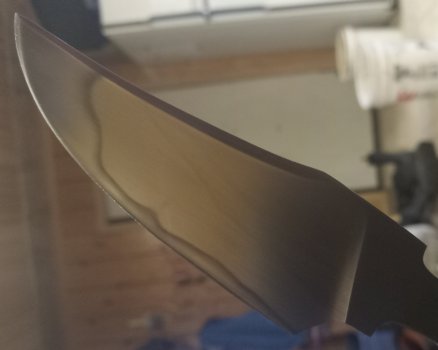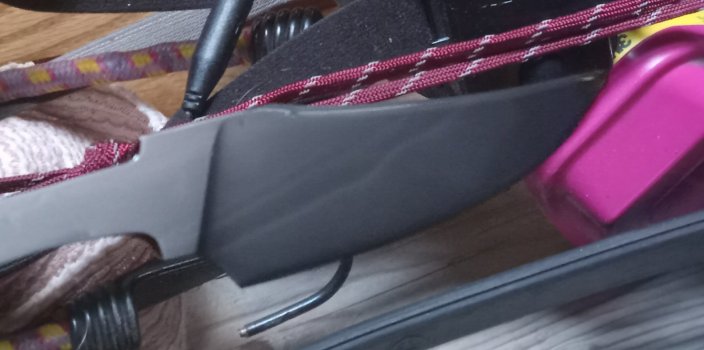My first hamon, using file steel, without extra little dark lines in it.

I have 1075 from Admiral that I was trying to forge and thermal cycle in order to reduce alloy banding. I got a nice hamon with it, but it had lines in the hamon which I think is alloy banding. So I'm still learning with the steel I have actually purchased - I noticed the same thing with 80CRV2 I heat treated that banding was more pronounced at the ricasso which wasn't hardened.
The way I understand it, the alloy banding is from cooling when it's made, and it's got to be cycled out by high temps and heat in order to not be present in the finished knife.
But I did notice that some 80crv2 I had commercially heat treated didn't have any banding in it.
So I wondered if I wasn't doing something right and decided to try with something that I knew had already been through industry heat treating.
This picture is from a file I forged, cycled, annealed, austenitized, and edge quenched. The bevels were ground at the edge since I was going for a hamon. No clay.
I "edge quenched" higher than the hamon - you can faintly see three lines higher up - but honestly it was too smoky and dark to see what I was doing. I do remember bumping the quench tank to make waves. Those top lines is the depth I remember quenching at.
Here's a second pic right out of the etch that shows it better:

What I think happened was that the steel was only fully astenitized at the edge because it was thinner.
So two issues: no alloy banding from the file as opposed to bar stock, but I think still not austenitized fully because of time at temp was too short.
Any thoughts?

I have 1075 from Admiral that I was trying to forge and thermal cycle in order to reduce alloy banding. I got a nice hamon with it, but it had lines in the hamon which I think is alloy banding. So I'm still learning with the steel I have actually purchased - I noticed the same thing with 80CRV2 I heat treated that banding was more pronounced at the ricasso which wasn't hardened.
The way I understand it, the alloy banding is from cooling when it's made, and it's got to be cycled out by high temps and heat in order to not be present in the finished knife.
But I did notice that some 80crv2 I had commercially heat treated didn't have any banding in it.
So I wondered if I wasn't doing something right and decided to try with something that I knew had already been through industry heat treating.
This picture is from a file I forged, cycled, annealed, austenitized, and edge quenched. The bevels were ground at the edge since I was going for a hamon. No clay.
I "edge quenched" higher than the hamon - you can faintly see three lines higher up - but honestly it was too smoky and dark to see what I was doing. I do remember bumping the quench tank to make waves. Those top lines is the depth I remember quenching at.
Here's a second pic right out of the etch that shows it better:

What I think happened was that the steel was only fully astenitized at the edge because it was thinner.
So two issues: no alloy banding from the file as opposed to bar stock, but I think still not austenitized fully because of time at temp was too short.
Any thoughts?

